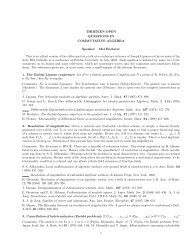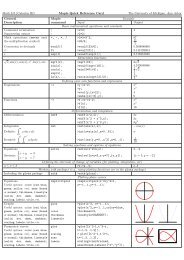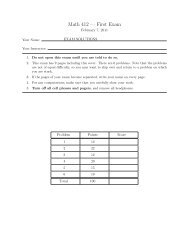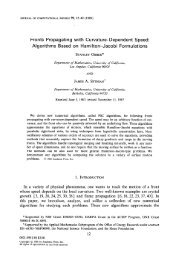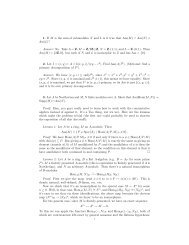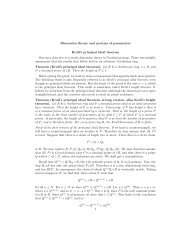Ellipse axes, eccentricity, and direction of rotation
Ellipse axes, eccentricity, and direction of rotation
Ellipse axes, eccentricity, and direction of rotation
Create successful ePaper yourself
Turn your PDF publications into a flip-book with our unique Google optimized e-Paper software.
Math 558<br />
Pr<strong>of</strong>. J. Rauch<br />
<strong>Ellipse</strong> Axes. Aspect ratio, <strong>and</strong>, Direction <strong>of</strong> Rotation for Planar Centers<br />
Thish<strong>and</strong>out concerns 2×2 constant coefficient real homogeneous linear systems X ′ = AX<br />
in the case that A has a pair <strong>of</strong> complex conjugate eigenvalues a±ib, b ≠ 0. The orbits<br />
are elliptical if a = 0 while in the general case, e −at X(t) is elliptical. The latter curves are<br />
the solutions <strong>of</strong> the equation<br />
X ′ = (A−aI)X,<br />
a = trA<br />
2 .<br />
For either elliptical or spiral orbits we associate this modified equation that has elliptical<br />
orbits. The new coefficient matrix A − (trA/2)I has trace equal to zero <strong>and</strong> positive<br />
determinant. These two conditions characterize the matrices with a pair <strong>of</strong> non zero<br />
complex conjugate eigenvalues on the imaginary axis. Those are the matrices for which<br />
the phase portrait is a center. We show how to compute the <strong>axes</strong> <strong>of</strong> the ellipse, the<br />
<strong>eccentricity</strong> <strong>of</strong> the ellipse, <strong>and</strong> the <strong>direction</strong> <strong>of</strong> <strong>rotation</strong>, clockwise or counterclockwise.<br />
§1. Direction <strong>of</strong> <strong>rotation</strong>.<br />
To determine the <strong>direction</strong> <strong>of</strong> <strong>rotation</strong> it suffices to find the <strong>direction</strong> <strong>of</strong> the <strong>rotation</strong> on the<br />
positive x 1 -axis. If the flow is upward (resp. downward) then the swirl is counterclockwise<br />
(resp. clockwise). For a matrix A that has no real eigenvalues, the <strong>direction</strong> <strong>of</strong> swirl is<br />
counterclockwise if <strong>and</strong> only if the second coordinate <strong>of</strong><br />
(<br />
1<br />
A<br />
0)<br />
=<br />
(<br />
a11<br />
a 21<br />
)<br />
is positive, if <strong>and</strong> only if a 21 > 0. The swirl is counterclockwise if <strong>and</strong> only if a 21 > 0.<br />
Freeing this computation from the choice (1,0) introduces an interesting real quadratic<br />
form. For any real X ≠ 0, the vectors X <strong>and</strong> AX cannot be parallel. Otherwise, X would<br />
be an eigenvector with real eigenvalue. Denote by [X,AX] the 2 × 2 matrix whose first<br />
column is X <strong>and</strong> second is AX. Then the quadratic form<br />
Q 1 (X) := det[X,AX] = AX ·X ⊥ , X ⊥ := (−x 2 ,x 1 ).<br />
is nonzero for all real X ≠ 0. Therefore Q 1 is either always positive or always negative on<br />
R 2 \0. The preceding criterion shows that the sign <strong>of</strong> Q 1<br />
(<br />
(1,0)<br />
)<br />
<strong>and</strong> therefore the sign <strong>of</strong><br />
Q 1 (X) determines the <strong>direction</strong> <strong>of</strong> <strong>rotation</strong>.<br />
This result can also be understood considering the angle θ in polar coordinates. On any<br />
curve (x 1 (t), x 2 (t)) that does not touch the origin,<br />
dθ(x 1 (t),x 2 (t))<br />
dt<br />
= ∂θ dx 1<br />
∂x 1 dt<br />
+ ∂θ dx 2<br />
∂x 2 dt<br />
= x 1x ′ 2 −x 2x ′ 1<br />
x 2 1 +x2 2<br />
, (1.1)<br />
the last equality involving the partials <strong>of</strong> θ.<br />
1
Exercise 1.1. Compute the partial deriviatives <strong>of</strong> θ(x 1 ,x 2 ) by differentiating the identity<br />
‖x‖ ( cosθ(x), sinθ(x) ) = x<br />
with respect to x 1 <strong>and</strong> x 2 .<br />
Formula (1.1) applied to solutions <strong>of</strong> X ′ = AX yeilds<br />
dθ<br />
dt<br />
= x 1x ′ 2 −x 2x ′ 1<br />
x 2 1 +x2<br />
=<br />
AX ·X⊥<br />
|X| 2<br />
= Q 1(X)<br />
|X| 2 .<br />
Therefore Q 1 has a geometric interpretation,<br />
The criterion for counterclockwise <strong>rotation</strong> is dθ/dt > 0.<br />
Q 1 (X) = |X| 2 dθ/dt. (1)<br />
Algorithm I. Q 1 (X) is a definite quadratic form <strong>and</strong> the <strong>direction</strong> <strong>of</strong> <strong>rotation</strong> is counterclockwise<br />
if <strong>and</strong> only if Q 1 > 0 on R 2 \0, <strong>and</strong> clockwise if <strong>and</strong> only if Q 1 < 0.<br />
Replacing A by A − αI mulitplies the solutions <strong>of</strong> the differential equation by e −αt <strong>and</strong><br />
does not change dθ/dt since X ·X ⊥ = 0. In particular,<br />
Q 1 (X) = AX ·X ⊥ = (A−(trA/2)I)X ·X ⊥ .<br />
§2. <strong>Ellipse</strong> axis <strong>direction</strong>s.<br />
Define a second quadratic form associated to the matrix A with complex conjugate eigenvalues.<br />
First replace A by A −(trA/2)I that has elliptical orbits <strong>and</strong> eigenvalues on the<br />
imaginary axis. The second quadratic form is defined by<br />
Q 2 (W) := (A−(trA/2)I)W ·W .<br />
The points where (A−(trA/2)I)X ⊥ X are the points where Q 2 = 0. For elliptical orbits,<br />
these are the <strong>direction</strong>s <strong>of</strong> the principal <strong>axes</strong>.<br />
.<br />
.<br />
.<br />
.<br />
2
The plane is divided into four quadrants by these <strong>direction</strong>s. In each quadrant Q 2 (W) has<br />
a fixed sign <strong>and</strong> changes sign exactly when v is along one <strong>of</strong> the principal <strong>axes</strong>.<br />
Algorithm II. For a center, the <strong>axes</strong> <strong>of</strong> the ellipse are the nonzero vectors W so that<br />
Q 2 (W) = 0. When the ellipse is noncircular this gives a pair <strong>of</strong> perpendicular lines that<br />
are the <strong>direction</strong> <strong>of</strong> the principal <strong>axes</strong> <strong>of</strong> the ellipse.<br />
Examples. i. For<br />
( )<br />
0 1<br />
A = ,<br />
−4 0<br />
Q 2 (X) = AX ·X AX = (x 2 ,−4x 1 ), Q(X) = −3x 1 x 2 .<br />
Since Q 2 (W) = −3w 1 w 2 , the equation <strong>of</strong> the <strong>axes</strong> is x 1 x 2 = 0. The <strong>axes</strong> are the usual<br />
euclidean <strong>axes</strong>.<br />
ii. For<br />
trA = 3−2 = 1, so<br />
A =<br />
A−(trA/2)I =<br />
( )<br />
3 5<br />
,<br />
−2 −2<br />
( )<br />
2.5 5<br />
−2 −2.5<br />
is the trace free matrix whose motion is a center. The equation determining the <strong>axes</strong> is<br />
0 = Q 2 (W) = 2.5w 2 1 +3w 1w 2 −2.5w 2 2 .<br />
Any nonzero solution must have w 1 ≠ 0. Dividing by w 1 shows that solutions are all<br />
multiples <strong>of</strong> W = (1,y) where,<br />
The roots are<br />
2.5+3y −2.5y 2 = 0, equivalently, 5y 2 −6y −5 = 0. (2)<br />
6± √ 6 2 −4(−5)(5)<br />
10<br />
= 6±√ 136<br />
10<br />
= 3±√ 34<br />
5<br />
The two roots yield the <strong>direction</strong>s (1,y 1 ) <strong>and</strong> (1,y 2 ) <strong>of</strong> the two <strong>axes</strong> <strong>of</strong> the ellipse. The<br />
orthogonality <strong>of</strong> the <strong>direction</strong>s is equivalent to the fact that the product <strong>of</strong> the roots is<br />
equal to −1. This follows from (2) since in the quadratic equation for y, the constant term<br />
<strong>and</strong> the coefficient <strong>of</strong> y 2 differ by a factor −1.<br />
iii. In the degenerate case where there are more than two <strong>direction</strong>s for which Q 2 = 0,<br />
one has a quadratic equation with more than two roots so the quadratic form vanishes<br />
identically <strong>and</strong> Q 2 is identically equal to zero. In this case the orbits are circular.<br />
§3. Major <strong>and</strong> minor <strong>axes</strong>.<br />
The differential equation with coefficient à := A−(trA/2)I has elliptical orbits. Compute<br />
orthogonal unit vectors W j along the <strong>axes</strong> <strong>of</strong> the associated ellipse using Algorithm II.<br />
Denote by Y the coordinates with respect to the basis W j ,<br />
X = y 1 W 1 + y 2 W 2 , with, y 1 = X ·W 2 , y 2 = X ·W 2 . (3.1)<br />
3<br />
.
Introduce the matrix T −1 whose first column is W 1 <strong>and</strong> second column is W 2 so<br />
Equation (3.1) asserts that<br />
From the definition <strong>of</strong> T −1 one has<br />
T −1 :=<br />
( )<br />
W1,1 W 2,1<br />
.<br />
W 1,2 W 2,2<br />
X = T −1 Y , equivalently Y = TX. (3.2)<br />
T −1 (1,0) = W 1 , T −1 (0,1) = W 2 , so, TW 1 = (1,0), TW 2 = (0,1). (3.3)<br />
Exercise 3.1 i. If the columns <strong>of</strong> a 2×2 matrix M form an orthonomal basis <strong>of</strong> R 2 show<br />
that M † M = I where † denotes transpose. ii. Use this to show that (T −1 ) † T −1 = I.<br />
Derive from this that TT † = T † T = I.<br />
X(t) satisfies X ′ = ÃX if <strong>and</strong> only if Y = TX satisfies Y ′ = TÃT−1 Y. Next compute<br />
TAT −1 to show that<br />
( )<br />
0 α<br />
TÃT−1 = , with α :=<br />
β 0 ÃW 2 ·W 1 , β := ÃW 1 ·W 2 . (3.4)<br />
The first column <strong>of</strong> TÃT−1 is equal to<br />
TÃT−1 (1,0) = TÃW 1.<br />
Exp<strong>and</strong> ÃW 1 with respect to the orthonormal basis <strong>of</strong> W’s to find<br />
Since (ÃW 1 · W 1 ) = 0 one has<br />
ÃW 1 = (ÃW 1 · W 1 )W 1 + (ÃW 1 · W 2 )W 2 = βW 2 .<br />
verifying the first column <strong>of</strong> (3.4).<br />
TÃW 1 = βTW 2 = (0,β)<br />
Exercise 3.2. Verify the second column <strong>of</strong> the identity.<br />
The formulas show that α <strong>and</strong> β are real. The determinant <strong>of</strong> A is positive <strong>and</strong> equal to<br />
the determinant <strong>of</strong> TAT −1 so αβ < 0 proving that α <strong>and</strong> β have opposite sign.<br />
The differential equation in Y coordinates is<br />
y ′ 1 = αy 2, y ′ 2 = βy 1.<br />
4
Multiply the first equation by βy 1 , the the second by αy 2 , <strong>and</strong> subtract to find<br />
0 = βy 1 y 1 ′ − αy 2y 2 ′ = 1 d(βy1 2 −αy2)<br />
2 .<br />
2 dt<br />
The orbits have equation βy1 2 − αy2 2 = constant. The phase portrait is a center iff these<br />
curves are ellipses iff α <strong>and</strong> β have opposite signs. In that case, the orbits are similar<br />
in the sense <strong>of</strong> Euclidean geometry to the ellipse |β|y1 2 + |α|y2 2 = 1. The <strong>axes</strong> are along<br />
the y-coordinate <strong>axes</strong>. The axis along the y 1 -axis (resp. y 2 -axis) has length |β| −1/2 (resp.<br />
|α| −1/2 ).<br />
Algorithm III. Suppose that W j are orthogonal unit vectors along the axis <strong>direction</strong>s<br />
found in Algorithm II <strong>and</strong> α <strong>and</strong> β are computed from formula (3.4). Then the elliptical<br />
orbits are similar to the ellipse with axis along W 1 <strong>of</strong> length |β| −1/2 <strong>and</strong> axis along<br />
W 2 <strong>of</strong> length |α| −1/2 . In particular the ratio <strong>of</strong> the shorter axis to the longer axis (:=<br />
<strong>eccentricity</strong>) is equal to<br />
min { |α| −1/2 , |β| −1/2}<br />
max { |α| −1/2 , |β| −1/2} .<br />
Examples. i. Choose W 1 = (1,0), W 2 = (0,1) unit vectors along the <strong>axes</strong> computed in<br />
§2. Then ( ) ( ( ) (<br />
0 1 1 0 0 0<br />
β = · = · = −4<br />
−4 0)(<br />
0 1)<br />
−4 1)<br />
( ) ( ( (<br />
0 1 0 1 1 1<br />
α = · = · = 1.<br />
−4 0)(<br />
1 0)<br />
0)<br />
0)<br />
The ellipses have <strong>axes</strong> along the x 1 <strong>and</strong> x 2 axis. The major axis is along x 2 <strong>and</strong> is longer<br />
by a factor 2 than the minor axis.<br />
ii. Choose,<br />
(<br />
U 1 = 1, 3+√ )<br />
34<br />
, W 1 = U (<br />
1<br />
5 ‖U 1 ‖ , U 2 = 1, 3−√ )<br />
34<br />
, W 2 = U 2<br />
5 ‖U 2 ‖ .<br />
Then<br />
β =<br />
α =<br />
(<br />
1 2.5 5<br />
‖U 1 ‖‖U 2 ‖ −2 −2.5<br />
1<br />
‖U 1 ‖‖U 2 ‖<br />
(<br />
2.5 5<br />
−2 −2.5<br />
)(<br />
1<br />
3+ √ 34<br />
5<br />
)(<br />
1<br />
3− √ 34<br />
5<br />
)<br />
)<br />
·<br />
·<br />
(<br />
1<br />
3− √ 34<br />
5<br />
(<br />
1<br />
3+ √ 34<br />
5<br />
The ellipses are similar to the ellipse with <strong>axes</strong> along W 1 <strong>and</strong> W 2 <strong>of</strong> lengths |β| −1/2 <strong>and</strong><br />
|α| −1/2 respectively.<br />
Exercise 3.3. If the <strong>axes</strong> are not along the x-<strong>axes</strong>, then the equation for x = x 1 /x 2<br />
in algorithm II has the form x 2 + ax − 1 = 0. Show that it is impossible to find an<br />
example where the roots are integers. Hint. The sum <strong>of</strong> the roots is equal to −a <strong>and</strong> the<br />
discriminant must be a perfect square.<br />
This may explain why you don’t find algorithms II, III in textbooks.<br />
5<br />
)<br />
,<br />
)<br />
,



